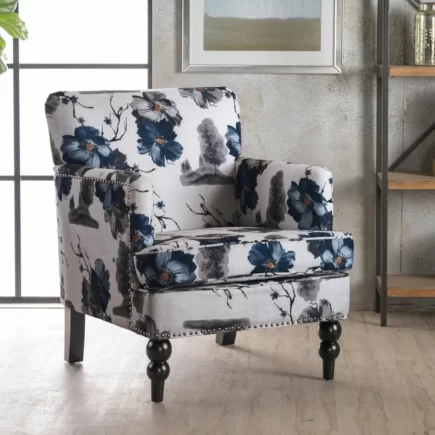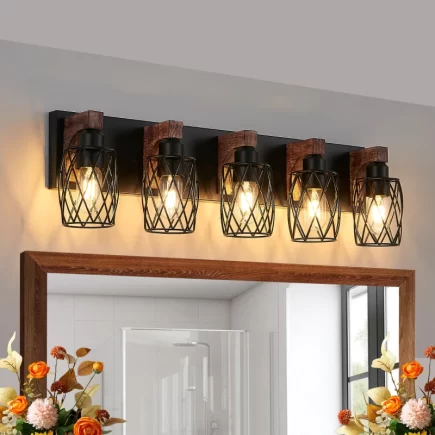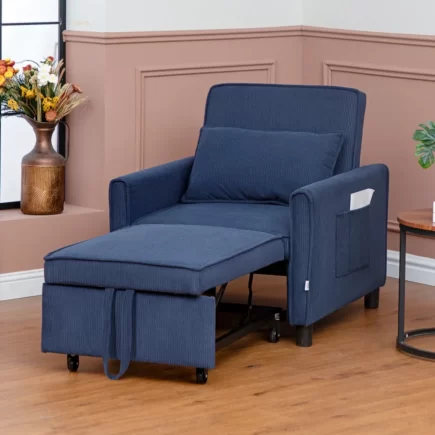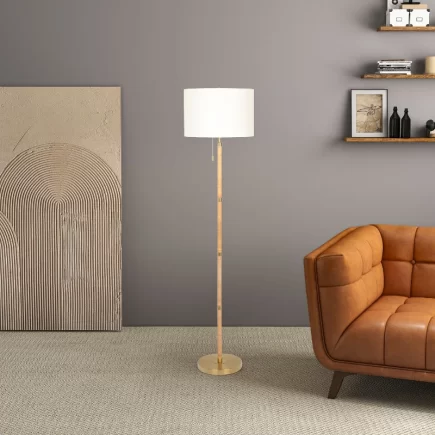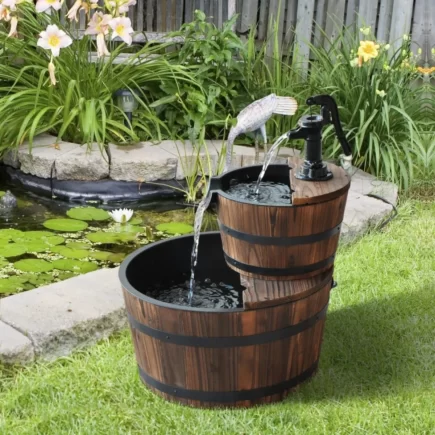We clean our floors, wipe down counters, and fluff pillows regularly, but when was the last time you gave your accent chair a proper cleaning? Whether it’s a mid-century piece that completes your living room aesthetic or a cozy reading nook essential, your accent chair collects far more than you might realize.

Dust, stains, pet hair, and odours can quickly accumulate, dulling the beauty and reducing the lifespan of your furniture. Cleaning an accent chair the right way isn’t just about appearance; it’s about hygiene, indoor quality, and preserving your investment.
Identify the Material and Fabric Cleaning Code
Before you even touch a cleaning product, you need to know what you’re dealing with. Cleaning the wrong way can permanently damage your upholstery.
Fabric Cleaning Codes: What Do They Mean?
Most accent chairs come with a manufacturer’s tag, usually hidden under the seat cushion or on the frame, that lists the fabric content and a cleaning code.
| Code | Meaning | Cleaning Method |
| W | Water-based cleaner | Safe to use water or water-based foam |
| S | Solvent-based cleaner only | Use dry cleaning solvent, no water |
| WS | Water or solvent-based cleaner | Use either, but test first |
| X | Vacuum or professional cleaning only | Do not use any liquid cleaner |
If the tag is missing or unclear, test your cleaner on a hidden area before applying it to visible surfaces.
General Tools and Cleaning Products

The right tools can make all the difference between success and an upholstery disaster. Here’s what you should gather before cleaning.
Essential Tools
- Vacuum with upholstery brush and crevice tool
- Soft-bristled brush or toothbrush
- Microfiber cloths or lint-free rags
- Spray bottle
Cleaning Agents
- Mild dish soap
- Baking soda
- White vinegar
- Enzyme cleaner (for organic stains)
- Leather conditioner (for leather/faux leather)
- Solvent-based upholstery cleaner (for “S” code)
Eco-Friendly Options
- Essential oils (lavender, eucalyptus, lemon)
- DIY baking soda + vinegar spray
- Plant-based commercial cleaners
Step-by-Step Accent Chair Cleaning Process
Whether your accent chair is made of velvet, polyester, leather, or a mix of materials, follow these steps for best results.
1. Dusting
Dusting is your first step; do this weekly to prevent buildup.
For Cotton, Polyester, and Velvet Accent Chair

- Use a vacuum with an upholstery brush attachment. Vacuuming removes dust, allergens, and debris embedded in the fibres. Use a HEPA-filtered vacuum for allergen control.
- For velvet, use a soft-bristle brush or lint roller to avoid crushing the nap.
- Gently brush or vacuum in the direction of the fabric weave to avoid damage.
- Clean crevices with a soft toothbrush or a vacuum crevice tool.
For Leather Accent Chair
- Wipe the surface using a dry microfiber cloth.
- For seams and corners, use a small paintbrush or cotton swab.
- Never use abrasive cloths that could scratch the surface.
2. Stain Removal
Cotton, Polyester, Velvet
Here’s how to remove the most common stains:

| Stain Type | Solution | Instructions |
| Food/Beverage | Mild dish soap + warm water | Dip the cloth, blot the stain, then rinse with clean water |
| Ink | Rubbing alcohol | Apply with a cotton swab, blot, not rub |
| Grease | Cornstarch or baking soda | Sprinkle over stain, wait 30 mins, vacuum, then blot with soapy water |
- For velvet, never oversaturate. Use dry foam cleaners or spray lightly.
- Always blot, don’t rub it, it pushes the stain deeper.
Leather
| Stain Type | Solution | Instructions |
| Water | Damp cloth | Wipe evenly across the panel to prevent ring marks |
| Ink | Leather-safe ink remover or rubbing alcohol | Dab gently with cotton swab |
| Oil/Grease | Dry cloth only | Never use water—it spreads the stain |
| General Dirt | Equal parts water + vinegar | Lightly apply with cloth, rinse and dry |
- Use minimal liquid. Leather is porous and may absorb excess moisture.
- Follow up with drying and conditioning.
3. Applying the Cleaning Solution
This is the step for deep cleaning, not just stain removal.
Cotton, Polyester, Velvet
- Choose a fabric-safe upholstery cleaner (foam or liquid).
- Apply to a cloth, not directly to the fabric.
- Wipe using circular or dabbing motions.
- Let the solution sit for a few minutes if needed, then blot with a damp cloth.
- Dry using a clean towel.
Leather
- Use a pH-balanced leather cleaner.
- Apply a small amount on a microfiber cloth.
- Work in gentle circular motions.
- Wipe off residue with a slightly damp cloth.
- Dry with a soft towel.
Drying
Moisture that lingers can lead to mildew or damage, so drying is key.
Fabric Upholstery (Cotton, Polyester, Velvet)
- Allow the chair to air-dry in a ventilated room.
- Avoid direct sunlight, which can fade colours.
- Use a fan to speed up drying.
- For velvet, brush the fabric lightly as it dries to preserve the nap.
Leather
- Wipe thoroughly with a dry cloth.
- Let it air-dry naturally away from direct heat or sunlight.
- Avoid using hair dryers or heaters, which can cause leather to crack.
Mistakes to Avoid
A few wrong moves can ruin a perfectly good chair. Watch out for:
- Using the wrong cleaner for the fabric code
- Over-wetting fabric (especially velvet or cotton)
- Ignoring spot tests
- Rubbing stains (which can spread or damage)
- Using heat to dry (which may shrink or warp materials)
Preventive Maintenance Tips
Consistency is key for keeping your accent chair fresh and stylish.
| Task | Frequency |
| Vacuuming | Weekly |
| Spot cleaning | As needed |
| Deodorizing | Monthly |
| Deep cleaning | Seasonally |
| Fabric protector spray | Every 6–12 months |
Clean Chairs, Clean Living
Accent chairs are more than just seating; they’re visual anchors that reflect your taste and enhance your space. Keeping them clean doesn’t require professional equipment or a weekend of labour. With the right materials, a structured process, and eco-conscious methods, you can restore and maintain the comfort and elegance of your favourite chair. Ready to add new charm to your space. Explore modern and classic Accent Chairs options at Aosom and pair them with the confidence of knowing how to care for them.
FAQs
1. Is it safe to use a carpet cleaner or upholstery machine on accent chairs?
Only if the fabric code is ‘W’ or ‘WS’ and the machine is labeled for upholstery use. Use the machine’s lowest water setting and avoid over-saturating the fabric. Test a small area first to make sure the suction doesn’t pull at the seams or distort the shape.
2. What is the safest accent chair cleaning product for kids and pets?
Baking soda is one of the safest cleaning products for homes with kids and pets. It’s non-toxic, naturally deodorizes, lifts stains, and works on most fabrics without harsh chemicals, making it ideal for routine maintenance of accent chairs
3. How to handle musty smells or mildew in a fabric accent chair?
Move the chair to a dry, ventilated area. Mix equal parts vinegar and water, lightly spritz the area, and let it sit for 10 minutes before blotting and drying. For severe mildew, a professional cleaning may be needed to prevent health risks.
4. Can steam cleaning be used on accent chairs?
Steam cleaning can be effective, but it depends on the fabric type and cleaning code. It’s generally safe for water-safe fabrics, but not for materials such as velvet, leather, or those that require solvent-based cleaning.





